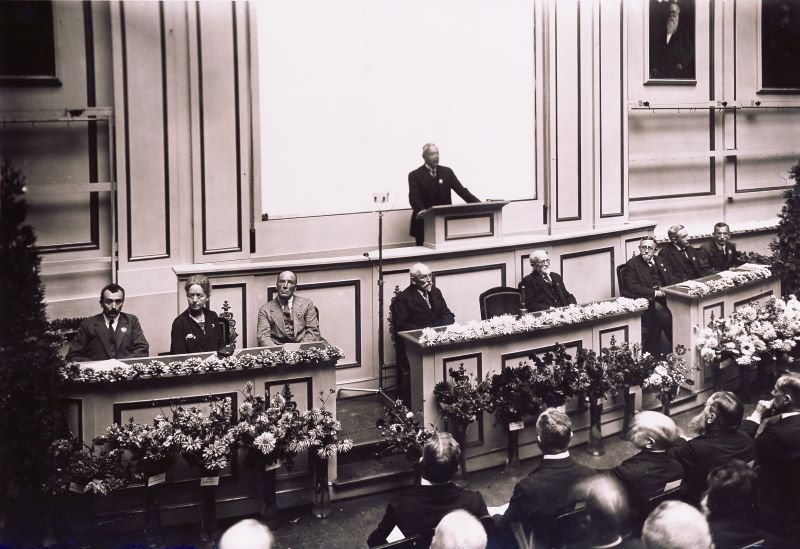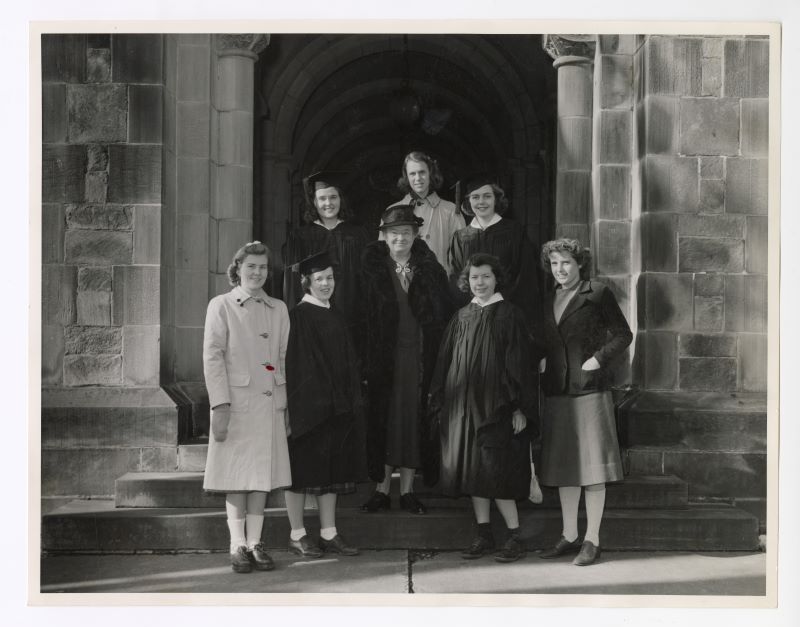About Women in Science at the APS
Project Overview
Women in the 19th and 20th centuries participated in science, a field that was sometimes open to them, but more often than not, was exclusionary.1 Some women scientists received notoriety and fame as women “firsts”—the first to attend a specific university, to work in a certain lab, or win a Nobel prize in science.2 These women “firsts,” such as Marie Curie, Florence Sabin, Barbara McClintock and others became well known in their time and are now often-cited heroines of the history of science. Their stories are powerful and significant; however, they are not the only stories of women in science.
Women “firsts” often relied on a wider network of women and men, friends and family, to support them. By triangulating the stories of other women scientists who corresponded with well-known women of science, this project seeks to recover biographies and information about women in science not previously known, as well as illustrate networks that were essential to sustaining women’s work in science.
Barriers to Women’s Participation


Although women have been active in science since early recorded history, structural barriers inhibited their full participation.3 Not only were women’s contributions to science dismissed on account of their gender and their presence unwelcome in the cultures of certain disciplines, administrative and legal policies prevented them from pursuing active careers in science.4 These included:
- Policies barring women from higher education;
- Anti-nepotism rules that prevented married women from receiving a salary at the same institution as their husbands;
- The relegation of women to “lesser” assistant positions, such as “computers” who did all of the calculations but received none of the credit;
- The marginalization of fields where women did find a place to practice science (e.g. home economics).
In the face of these structural barriers, women nonetheless found their ways into institutionalized science. It is the thesis of this project that women scientists developed networks of support—both formal and informal, both within the university system and without—to help overcome the hurdles preventing their participation in science.5 Sometimes these networks included men to varying degrees. Often these networks were maintained and supported solely by women. Some women worked outside male-dominated institutions and did science in any way they could: in their homes, at all-women’s colleges, assisting their husbands, and so on. By mapping and visualizing these networks of support, the project aims to highlight the widespread efforts of women scientists to promote each other and also show how, behind the famous “firsts” of science, there were also large numbers of other women who have not received the same recognition.
Who counts as a scientist? What counts as science?


Part discovery work, part recovery effort, this visualization portrays women working in the hard sciences, such as medicine and physics, alongside fields like home economics, child welfare, and social work. These fields became “feminized” yet were professional spaces that women trained in science occupied. In making these choices we had to ask ourselves what counts as science and who is a scientist.
As project creators and academics ourselves, we are aware of the blending of disciplines and the significance of categorizing what is science and what is not. Other scholars have articulated this better than we can and so while we acknowledge the ongoing debate, we approached who is a scientist and what is science based on the project’s scope and what the team members could feasibly tackle with our resources.6 The Library of the American Philosophical Society has bountiful collections related to women in science, and one could spend years detailing the rich scientific contributions and the beautiful life of a figure like Florence Sabin. Our goals were instead to capture the networks of women working in and around Sabin and other “first” or well-known women scientists. At this time, given the resources available, we limited our search to five figures with broad scope from medicine to biology to crystallography and beyond. We did not include figures in the social sciences (for example, anthropology) or in pseudosciences (for example, eugenics), although we acknowledge these could be mined for additional connections in the future.
Equally important is the question of who counts as a scientist. For example, the case of Carrie B. Fuld is illustrative. Born to the Bamberger family, prominent department store owners in Baltimore, Carrie Fuld contributed over $23 million to endow the Institute of Advanced Study at Princeton. She supported the work of Florence Sabin and even admitted in a letter to Sabin that she felt she had “discovered” her talent. While interested in science, and wealthy enough to fund it, Fuld was not trained as a scientist, yet she is a woman who through her financial contributions and dedication to Sabin’s work as a scientist made a scientific contribution. While she may not be a scientist, she is clearly a woman of science and therefore we include her in the network.


Also embedded within the question of who counts as a woman in science are the legacies of racism, slavery and colonialism.7 In the early decades of the network as women pushed a wedge into scientific fields, most who became known as scientists were white and worked in all-white institutions. As opportunities for women in science broaden in the 20th century, more diverse representation of women from Mexico, India, China, and the Philippines show up in the network. Yet women’s contributions to science weren’t always as educated professionals, as the case of Henrietta Lacks shows. Lacks, whose cells were used without her or her family’s knowledge to create the first immortal line of cells, does appear in the archive as “HeLa”—no direct mention is made to her name beyond this. Yet the presence of HeLa cell references on their own within the archive illustrates the power structures within institutions of science, including the archive, and consequently, within the network. To learn more, visit our data story on gaps and silences within the archive. While Lacks was not a scientist, her contributions to science are boundless and continue to this day. She is included in the network.
This visualization is one way to research women in science as represented within the collections of the American Philosophical Society Library. Women in science who are not mentioned in the holdings won’t appear in the visualization. For example, as of now, we do not have Vassar College astronomer Maria Mitchell in the network—only because she was not referred directly within the surveyed collections and therefore does not appear as a data point. This is one limitation of our method, but as with any digital tool, it would be dishonest to claim that this resource covers everything, everywhere, all at once. Perhaps with future resources and collaborations we may be able to broaden our source material. What this tool can do is show the lineages between women scientists, recover women scientists mentioned in more well-known scientists’ letters, and serve as a point of discovery to learn more about how women navigated science and collegial relationships in the 20th century.
Project Timeline
- Phase One: 2018
Process: Data gathered by Serenity Sutherland as part of a Digital Humanities Fellowship at the American Philosophical Society Library. - Phase Two: 2018-2019
Process: Initial prototype network visualization prepared. Data restructured from CSV to JSON format by Cynthia Heider and Bayard L. Miller and visualized using JavaScript InfoVis Toolkit.
Deliverables: Internal prototype network visualization. - Phase Three: Spring-summer 2022
Process: Serenity Sutherland returned to the APS for another fellowship to refine and expand the dataset. David Ragnar Nelson proposed a new data structure and Nelson and Sutherland reformatted the data. Nelson wrote python scripts to convert Sutherland’s CSVs into JSON and built a prototype visualization using D3.js. - Phase Four: Summer-Fall 2022
Process: David Nelson and Bayard Miller conducted a survey of the collections of male scientists to fill in gaps in the network. Filtering features were added to the visualization. Mackenzie Mahoney, Nelson, Graziella Pierangeli, and Serenity Sutherland wrote biographies for women scientists. - Phase Five: Winter 2022-2023
Process: David Nelson designed the project website to contextualize the visualization. Data stories written by Nelson and Serenity Sutherland with assistance from Bayard Miller. Final data cleaning and enrichment performed by Nelson and Sutherland.
Deliverables: Release of the final website and visualization, publication of the dataset to the Digital Library and GitHub, publication of code and template data to GitHub.
Recommended Citation
Sutherland, Serenity, David Ragnar Nelson, and Bayard L. Miller. Visualizing Women in Science. American Philosophical Society. Site Version 1.8.2. last modified July 24, 2024. https://diglib.amphilsoc.org/womeninscience
References
-
Londa Schiebinger, The Mind Has No Sex? Women in the Origins of Modern Science (Cambridge: Harvard University Press, 1989), 11. A brief list of other literature that addresses the gendered arguments that prohibited, or in some cases, promoted women’s access to science include Kimberly A. Hamlin, From Eve to Evolution: Darwin, Science, and Women’s Rights in Gilded Age America (Chicago: University of Chicago Press, 2014); Margaret Rossiter, Women Scientists in America: Forging a a New World since 1972 (Baltimore: Johns Hopkins University Press, 2012); Darren N. Wagner and Joanna Wharton, “The Sexes and the Sciences” Journal of Eighteenth-Century Studies 42, no. 4 (2019): 399-413; Leonard Bernstein, Alan Winkler and Linda Zierdt-Warshaw, African and African American Women of Science (1998). ↩
-
Margaret Rossiter, Women Scientists in America: Struggles and Strategies (Baltimore: Johns Hopkins University Press, 1982), 158-159. Julie Des Jardins, The Madame Curie Complex: The Hidden History of Women in Science (New York: The Feminist Press at the City University of New York, 2010). ↩
-
Anna Reser and Leila McNeil, Forces of Nature: The Women Who Changed Science (2021). ↩
-
For how culture operated within science, medicine in particular, see Ellen S. More, Elizabeth Fee, Manon Parry, eds, Women Physicians and the Cultures of Medicine (Baltimore: Johns Hopkins University, 2008). ↩
-
Much has been written about the significance of women’s club work in organizations like the American Association for University Women. A short list includes Kathryn Kish Sklar, “Hull House in the 1890s: A Community of Women Reformers,” Signs (1985): 658-77; Robyn Muncy, Creating A Female Dominion in American Reform, 1890-1935 (New York: Oxford University Press, 1994); Lori D. Ginzberg, Women and the Work of Benevolence: Morality, Politics, and Class in the Nineteenth-Century United States (New Haven: Yale University Press, 1990); Ellen Fitzpatrick, Endless Crusade: Women Social Scientists and Progressive Reform (New York: Oxford University Press, 1990); Joan Marie Johnson, Funding Feminism: Monied Women, Philanthropy, and the Women’s Movement, 1870-1967 (Chapel Hill, NC: University of North Carolina Press, 2017). ↩
-
A short list of sources on how science has come to be defined, and issues of what counts as science, see Sally Gregory Kohlstedt, The Formation of the American Scientific Community: The American Association for the Advancement of Science, 1848-1860 (Urbana: University of Illinois Press, 1976); Paul Lucier, “The Origins of Pure and Applied Science in Gilded Age America,” ISIS Vol. 103, 2012, No, 3: 527-536. ↩
-
Londa Schiebinger, “The Anatomy of Difference: Race and Sex in Eighteenth-Century Science,” Eighteenth-Century Studies 23 (no. 4, 1990): 387-405; Donald A. Barr, Health Disparities in the United States: Social Class, Race, Ethnicity, and Health (2008); Mark Harrison, Climates and Constitutions: Health, Race, Environment and British Imperialism in India, 1600-1850 (1999); Narin Hassan, Diagnosing Empire: Women, Medical Knowledge, and Colonial Mobility (New York: Routledge, 2011). ↩